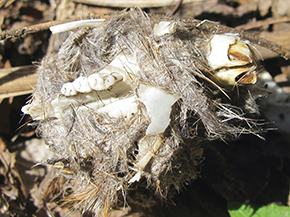
MOISÉS SILVA LIMAAfter swallowing rodents whole…MOISÉS SILVA LIMA
Some biologists who study marsupials and rodents can recruit a pretty unusual kind of field assistant: owls. One such highly qualified helper, found almost everywhere in Brazil, is the barn owl (Tyto furcata) – whose skill at hunting small mammals has earned it the nickname “flying mousetrap”. Barn owls are effective assistants because, like other owls, they eat their prey whole and then regurgitate the bones and fur in a dry pellet. A research group from the Federal University of Espírito Santo (UFES), coordinated by biologist Yuri Leite, analyzed the DNA extracted from pellets regurgitated by barn owls in the south of the state of Pará, at the border with the states of Mato Grosso and Tocantins, on the banks of the Araguaia River – a transition area between the Cerrado and Amazon biomes (Systematics and Biodiversity, May 2015).

KRISTINE PAULUS… a barn owl regurgitates bones and furKRISTINE PAULUS
The pellets were collected during the doctoral studies of Portuguese biologist Rita Rocha, advised by Carlos Fonseca at the University of Aveiro and Leonora Costa at UFES. The genetic material extracted from the bones revealed 11 species of mammals, including two marsupials never before seen in that area and only previously reported in the northern Amazon. Some of the rodents eaten by the owls may belong to unknown species. The effectiveness of the birds has led the researchers to suggest that zoologists make a habit of collecting regurgitated owl pellets, a simple procedure that does not require special storage measures.
Republish